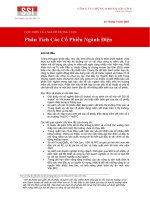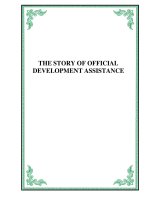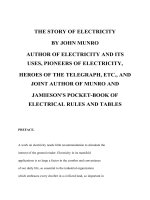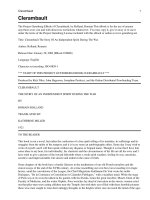eruption the story of volcanoes
Bạn đang xem bản rút gọn của tài liệu. Xem và tải ngay bản đầy đủ của tài liệu tại đây (2.64 MB, 35 trang )
READERS
Eruption!
The Story of Volcanoes
ANITA GANERI
A Note to Parents and Teachers
DK READERS is a compelling reading programme for
children. The programme is designed in conjunction with
leading literacy experts, including Cliff Moon M.Ed., who
has spent many years as a teacher and teacher educator
specializing in reading. Cliff Moon has written more than
160 books for children and teachers. He is series editor to
Collins Big Cat.
Beautiful illustrations and superb full-colour photographs
combine with engaging, easy-to-read stories to offer a fresh
approach to each subject in the series. Each DK READER is
guaranteed to capture a child’s interest while developing his or
her reading skills, general knowledge, and love of reading.
The five levels of DK READERS are aimed at different
reading abilities, enabling you to choose the books that
are exactly right for your child:
Pre-level 1: Learning to read
Level 1: Beginning to read
Level 2: Beginning to read alone
Level 3: Reading alone
Level 4: Proficient readers
The “normal” age at which a child begins to read can be
anywhere from three to eight years old. Adult participation
through the lower levels is very helpful for providing
encouragement, discussing storylines and sounding
out unfamiliar words.
No matter which level you
select, you can be sure that you
are helping your child learn to
read, then read to learn!
LONDON, NEW YORK, MUNICH,
MELBOURNE,
AND DELHI
Project Editor Deborah Lock
Art Editor C. David Gillingwater
Senior Art Editor Clare Shedden
Production editor Siu Chan
Picture Researcher Marie Osborn
Jacket Designer Natalie Godwin
Indexer Lynn Bresler
Reading Consultant
Cliff Moon, M.Ed.
Published in Great Britain by
Dorling Kindersley Limited
80 Strand, London WC2R ORL
Copyright © 2010 Dorling Kindersley Limited
A Penguin Company
2 4 6 8 10 9 7 5 3 1
177248 - 15/12
All rights reserved. No part of this publication may be reproduced,
stored in a retrieval system, or transmitted in any form or by
any means, electronic, mechanical, photocopying, recording,
or otherwise, without the prior written permission
of the copyright owner.
A CIP catalogue record for this book
is available from the British Library
ISBN: 978-1-40535-249-9
Colour reproduction by Colourscan, Singapore
Printed and bound in China by L. Rex Printing Co. Ltd.
The publisher would like to thank the following for
their kind permission to reproduce their images:
Key: t=top, a=above, b=below, l=left, r=right, c=center
Bridgeman Art Library, London / New York: Giraudon 32cr.
Corbis UK Ltd: Front jacket, 2tr, 2br, 20br, 30tc, 31.
Ecoscene: 22cb; Peter Hillme 24. Mary Evans Picture Library: 32tl.
Robert Harding Picture Library: 3, 15, 16tr, 16-17; Vulcan 15.
N.H.P.A.: Brian Hawks 27. Oxford Scientific Films: Anne Head 14.
Pa Photos: 4. Planet Earth Pictures: 13, 19c, 23tc; Dorian Wiesel 29.
Science Photo Library: 5; David Halpern 25; NASA 32br;
Peter Ryan 26. Frank Spooner Pictures: 9. Tony Stone Images:
Back jacket, 7. Topham Picturepoint: 12tc, 18bc, 32cl.
Jacket images: Front: National Geographic Stock: Carsten Peter
All other images © Dorling Kindersley
For further information see: www.dkimages.com
Discover more at
www.dk.com
Written by Anita Ganeri
Eruption!
THE STORY OF VOLCANOES
A Dorling Kindersley Book
READERS
What looks like a mountain
but spits out fire?
What shoots clouds of smoke
from a hole in its top?
What sometimes explodes
with a BANG?
4
5
A volcano!
It’s starting to erupt.
But inside the earth,
it is so hot that the rocks melt.
The rocks are runny
like melted butter.
6
Melted rock
Inside a volcano,
the melted rock rises
because it is hotter
and lighter than the
rocks around it.
The story of a volcano
starts underground.
If you jump up and down
on the ground,
it feels solid and hard.
Melted
rock
Sometimes the melted rock
bursts up through a hole
or a crack in the ground.
This is how a volcano begins.
7
The rock that comes out of
a volcano is called lava.
At first, it is runny
and red-hot.
It cools down
in the air and
turns into hard,
black rock.
8
Cooled lava
9
Some volcanoes spurt out
fiery fountains of lava.
Other volcanoes pour out lava
in great rivers of fire.
Once the lava starts flowing,
nothing can stop it.
It can bury whole villages
and set trees and
houses on fire.
Volcanoes have different shapes
and sizes.
Some volcanoes erupt with a bang.
Hot rocks and ash
shoot high into the air.
These volcanoes form
cone-shaped mountains
with steep sides.
10
The biggest volcano
Mauna Loa in Hawaii
is the biggest volcano in
the world. It is an
amazing 5,846 metres
(18,000 feet) high.
11
Other volcanoes erupt quietly.
The lava oozes gently out of the top
and spreads out all around.
These volcanoes are low and wide.
Some volcanoes erupt violently.
They blast out
clouds of hot ash and dust.
The ash is made of
tiny pieces of lava.
The ash and dust
shoot high into the air.
Some of it lands near the volcano.
It covers buildings and fields
in thick, dark grey powder.
12
13
Some ash and dust is carried away
by the wind.
It can block out the sun and
turn day into night.
At the top of a volcano
is a hollow called a crater.
In it is a hole called the vent.
Lava, ash and dust
come out of the vent.
Some craters are huge and can
be many kilometres (miles) wide.
14
15
When a volcano stops erupting,
the crater is left.
Some old craters fill up with water
to form huge lakes.
Sometimes the crater becomes
a dry, grassy plain.
Extinct volcanoes
We call a volcano that
has stopped erupting
‘extinct’. It will probably
never erupt again.
16
17
When a volcano shoots out lava
and ash, we say that it is erupting.
We call a volcano
that is erupting ‘active’.
Kilauea in Hawaii is
the most active
volcano on earth.
It has erupted non-stop
since 1983!
We call a volcano that is not
erupting ‘dormant’.
That means it is sleeping,
but it could erupt at any time.
Montserrat is a tiny island
in the Caribbean Sea.
It used to be a beautiful place
to live.
Then, in 1995, a volcano called
Chance’s Peak started to erupt.
18
19
It had been dormant for 400 years.
Many people had to leave
their homes as ash fell everywhere.
Some left the island
and went to live
in another country.
It was too dangerous
for them to stay.
Volcanic ash
Mount Vesuvius is a volcano
in Italy.
In AD 79, Mount Vesuvius
erupted violently, blasting hot ash
and gas into the air.
The ash buried the town
of Pompeii and
thousands of people died.
Today, people have cleared
the ash away.
You can walk around
the streets of Pompeii and
see the Roman ruins.
20
A cast of a dog
covered by the ash.
21
The ruins of the
Roman town of Pompeii
22
Pumice stone
Pumice stone is a type of
lava. It is used for rubbing
away hard skin. It is the only
type of rock that floats.
Volcanoes can be useful.
On the slopes of volcanoes,
the soil is good for growing crops.
23
In some places, blocks of solid lava
are used to build roads,
bridges and houses.
Precious gold
and diamonds
are found in
some volcanic rock.









